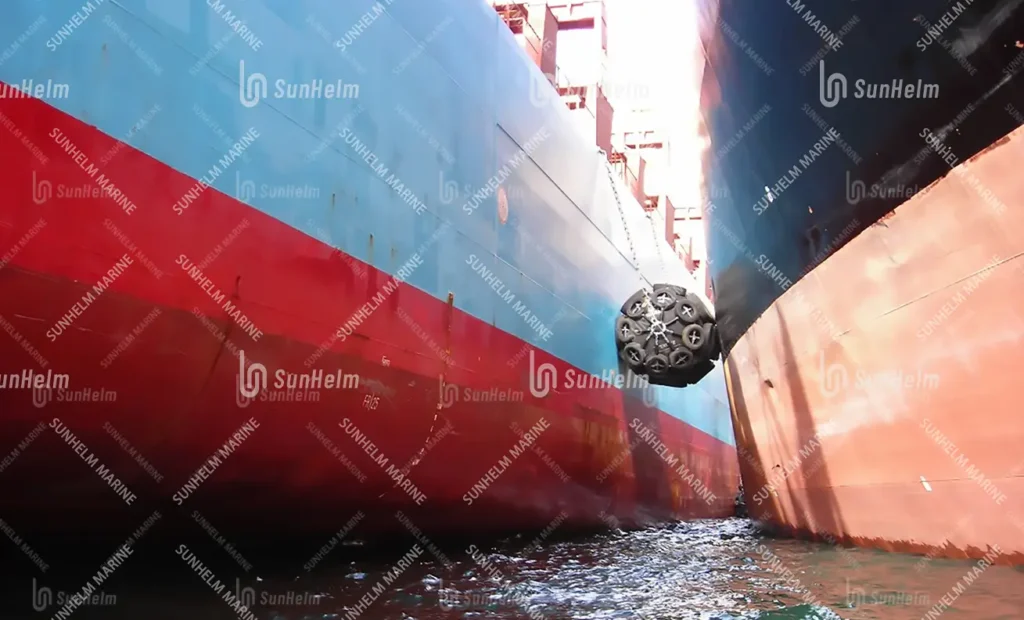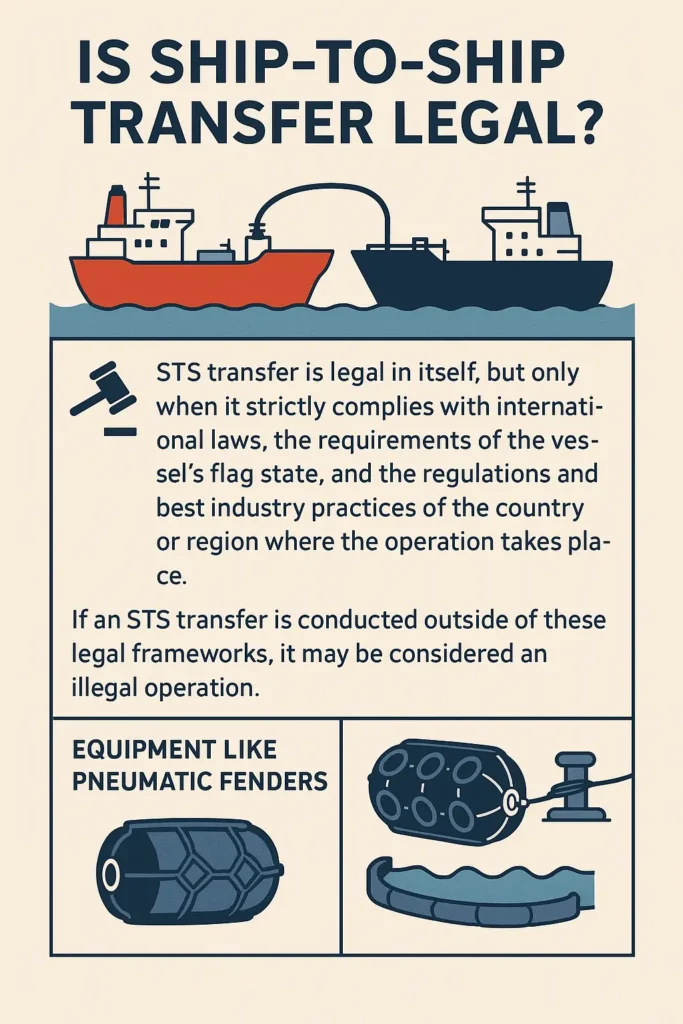Ship-to-Ship (STS) transfer is legal in itself, but only when it strictly complies with international laws, the requirements of the vessel’s flag state, and the regulations and best industry practices of the country or region where the operation takes place. If an STS transfer is conducted outside of these legal frameworks, it may be considered an illegal operation.

1. Introduction: What Is Ship-to-Ship Transfer (STS)?
Ship-to-ship (STS) transfer is the process of moving cargo—usually liquid bulk like crude oil, LNG, or chemicals—between two vessels positioned side by side at sea or in port. It’s commonly used for lightering operations, avoiding port congestion, emergency offloading, or transferring cargo between differently flagged vessels.
But is this kind of operation legal? The answer is yes—but only when it’s done by the book. Legality depends on complying with international maritime law, national regulations, and proper equipment use.
2. Is STS Transfer Legal?
2.1 Under International Law (IMO & MARPOL)
Yes, STS transfers are legal if done according to international rules. The International Maritime Organization (IMO), through the MARPOL Convention Annex I, Chapter 8, requires that oil tankers of 150 gross tons or more follow a government-approved STS Operations Plan. This includes procedures for pollution prevention, risk management, personnel responsibilities, and detailed documentation.
These rules came into effect in January 2011, making compliance mandatory for flagged vessels engaging in STS operations involving oil cargoes.
2.2 National Regulations (e.g., the United States)
Countries like the United States have stricter regulations. Under 33 CFR Part 156 Subpart D, the U.S. Coast Guard requires:
- Advance notice of at least 48 hours before any STS transfer occurs in U.S. waters.
- Detailed reporting of vessels involved, cargo type, location, time, and operator credentials.
- Mandatory approval of the transfer plan.
Failure to comply can lead to fines, vessel detention, or even criminal charges.
2.3 STS for Chemicals and LNG
STS transfers of chemicals, LPG, or LNG are also allowed but are not specifically covered under MARPOL Annex II or III. Instead, these must follow guidelines within the International Safety Management Code (ISM), and many flag states or port authorities require that LNG transfers adhere to OCIMF/ICS guidelines.
3. Why Compliance Matters
The legal status of STS transfers hinges on strict compliance. Regulators want to ensure:
- Proper environmental safeguards are in place.
- Qualified personnel are supervising operations.
- High-risk maneuvers at sea are carefully controlled.
Non-compliance not only violates maritime law but can cause pollution, injuries, or costly litigation.

4. Equipment Used in STS Operations
Proper equipment is key to safe and legal STS operations. Let’s look at what’s required:
| Equipment | Purpose |
|---|---|
| Pneumatic Fenders | These are essential for cushioning the space between two vessels. They absorb energy during contact and prevent hull damage. Must meet ISO 17357-1:2014 standards. |
| Secondary Fenders / Safety Mats | Provide additional hull protection in areas not covered by primary fenders. |
| Mooring Lines & Gear | Used to secure the ships together. Must follow OCIMF MEG4 recommendations. |
| Cargo Transfer Hoses | These must be compatible with the cargo type (oil, LNG, etc.) and have breakaway couplings to prevent spills during emergencies. |
| Oil Spill Response Kits | Including containment booms, skimmers, and absorbent pads—required on site to handle any accidental discharge. |
| Gas Detectors & Safety Valves | Especially important for LNG/LPG operations to detect flammable gas leaks. |
| Communication Systems | Radios or satellite communications to keep both vessels and support teams in sync. |
Among all of these, pneumatic fenders play a central role. Without them, hull-to-hull contact during STS transfer could cause serious structural damage or even breach containment—potentially leading to oil spills and legal trouble.
5. Risk Management and Personnel
A key legal requirement is having qualified supervisors. International guidelines require a POAC (Person in Overall Advisory Control) or Mooring Master onboard to manage the transfer.
Operations must be backed by:
- A written Joint Operation Plan (JOP).
- Thorough risk assessment.
- Clear emergency stop protocols.
Everyone involved must be trained, and vessels should hold drills to prepare for accidents like hose failure, sudden swell, or shifting positions.
6. Reporting & Documentation
If you’re operating in regulated waters (e.g., near the U.S.), the law requires:
- Advance notice of operations (e.g., 48 hours for U.S. Coast Guard).
- Accurate documentation in the ship’s Oil Record Book.
- Retention of all records for up to 3 years.
- Immediate reporting of any spill or deviation.
Failing to document properly can turn an otherwise legal operation into a punishable offense.
7. Common Legal Risks in STS Transfers
Even if STS transfer is “technically legal,” here are a few mistakes that can make it illegal:
- Using non-compliant fenders (e.g., not ISO-certified).
- No approved STS plan onboard.
- Failure to notify authorities.
- Unqualified personnel leading the operation.
- Spill response kits missing or expired.
8. Conclusion
Yes, ship-to-ship transfers are legal—but only when performed under the right legal and technical framework.
To stay compliant:
- Follow MARPOL Annex I and local laws.
- Use ISO-standard equipment, especially pneumatic fenders.
- Hire experienced STS service providers and certified POACs.
- Report, document, and prepare for emergencies.
If you operate in STS zones—especially oil and gas routes—make sure your gear, crew, and plans are ready and legal. Cutting corners here could cost you more than just money—it could lead to pollution, lawsuits, or a complete operations shutdown.


